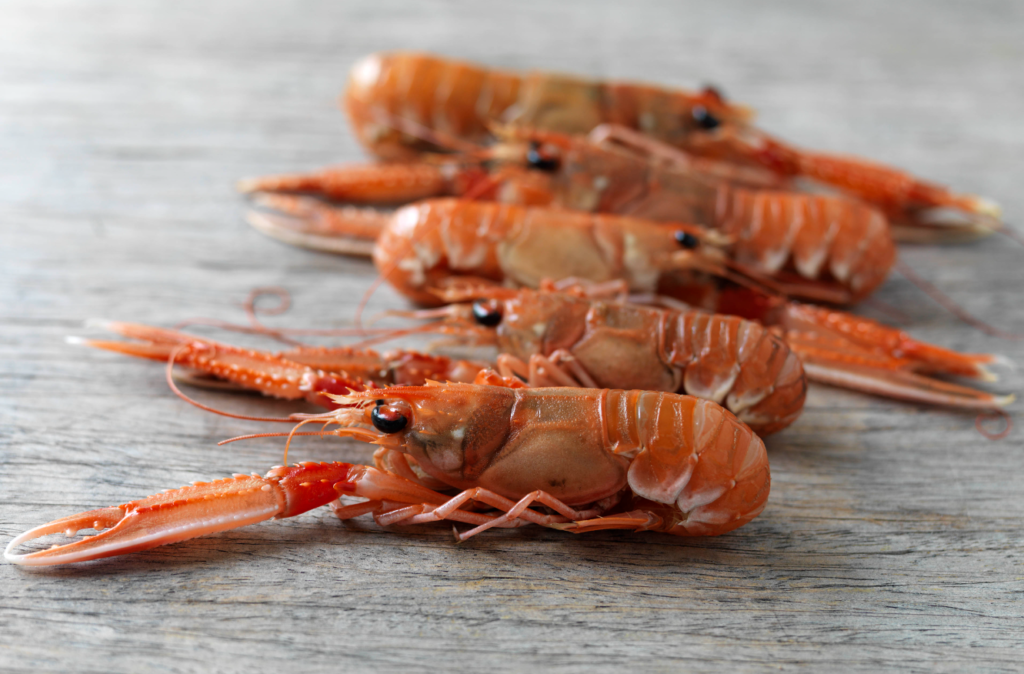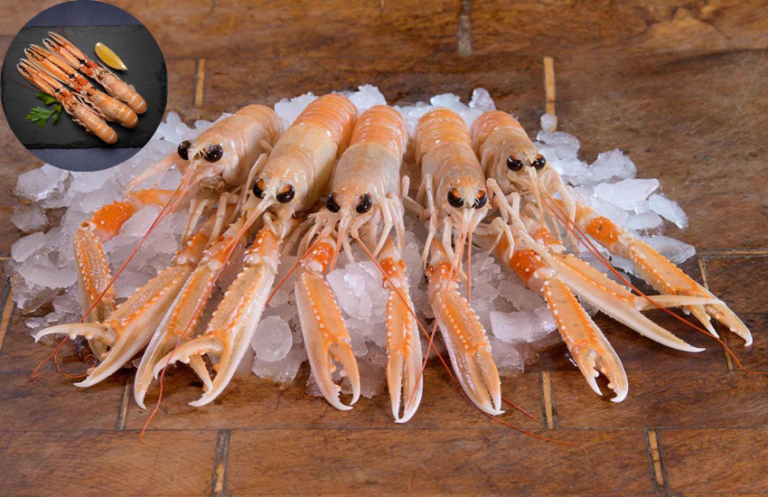Langoustine, a prized delicacy from the icy waters of the North Atlantic, is a true treasure of the seafood world. Known for its sweet, tender meat and delicate flavor, langoustine is often considered the gourmet’s choice when it comes to shellfish. It’s closely related to both lobsters and shrimp but stands out due to its unique taste and texture, making it a star ingredient in fine dining around the globe. If you’ve ever wondered “what is langoustine?” or how it differs from other shellfish, you’re in the right place. This guide will delve into everything from the basics of langoustine to its various culinary uses, including langoustine recipes, langoustine scampi, and the luxurious langoustine bisque.
Langoustine Profile
| Common Name | Langoustine |
|---|---|
| Scientific Name | Nephrops norvegicus |
| Also Known As | Norway lobster, Dublin Bay prawn |
| Size | Typically 6-10 inches |
| Habitat | North Atlantic Ocean, Mediterranean Sea |
| Flavor | Sweet, delicate, tender |
| Common Uses | Grilled, sautéed, bisques, scampi, pastas |
| Nutritional Value | High in protein, low in fat, rich in Omega-3 fatty acids |
What is Langoustine?
Langoustine (Nephrops norvegicus), also known as Norway lobster or Dublin Bay prawn, is a type of crustacean that thrives in cold, deep waters, particularly in the North Atlantic Ocean and the Mediterranean Sea. Despite being called a “lobster,” it’s much smaller than the lobsters we’re accustomed to. A typical langoustine measures between 6 and 10 inches in length, with its body resembling a mini lobster, complete with claws and a pale orange or pinkish shell.

What sets langoustine apart from other shellfish is its incredible flavor. Often described as having a sweet, mild taste, its flesh is tender, succulent, and less dense than that of lobster, with a texture more similar to shrimp. Langoustine is highly prized in European cuisine, particularly in France, Spain, and Italy, where it is often prepared simply to highlight its natural sweetness. It’s commonly served grilled, poached, or sautéed, but is also used in luxurious dishes like langoustine bisque.
Langoustine vs Lobster: What’s the Difference?
While langoustine and lobster are both crustaceans, they differ in many ways, both in size and taste. Langoustines are much smaller than lobsters, typically reaching only about a foot long, compared to the much larger lobsters that can grow over 2 feet. This size difference means that langoustine yields much less meat, which adds to its exclusivity and price in high-end markets.
Flavor:
Lobsters tend to have a more robust, almost briny flavor, with firmer meat. Langoustines, on the other hand, have a delicate, sweet taste that is more subtle and refined. Their meat is softer and silkier, making them a favorite for those who prefer a more delicate seafood experience.
Texture:
Lobster meat, especially from the claws, tends to be denser and chewier, while langoustine is softer and more tender. Langoustine is often compared to shrimp in terms of texture, although it’s a bit more refined and less fibrous.
Price and Availability:
Due to their smaller size and more limited harvest areas, langoustines are typically more expensive than lobsters. Langoustine is often considered a luxury item on restaurant menus, while lobster, though still a premium item, is generally more widely available.
Culinary Uses of Langoustine
Langoustine’s delicate flavor makes it a versatile ingredient in the kitchen, capable of being used in a variety of dishes that range from simple to elaborate. Its sweetness and tenderness make it a perfect companion for light, creamy sauces, and its natural elegance lends itself well to fine dining.
1. Langoustine Scampi
Langoustine scampi is a classic dish that showcases the beauty of this shellfish. In many parts of the world, the word “scampi” refers to the preparation of shrimp or prawns in a garlic butter sauce, often served with pasta or over rice. However, in the UK and parts of Europe, the traditional “scampi” refers to langoustines that are lightly breaded and fried.
In its simplest form, langoustine scampi can be made by sautéing langoustines in garlic, butter, and white wine until they’re just cooked through. The sweet, buttery sauce pairs perfectly with the delicate meat, creating a dish that is both rich and light.
2. Langoustine Bisque
Langoustine bisque is a luxurious, velvety soup made from langoustine shells, which are simmered with aromatics and stock to extract their deep, rich flavors. The bisque is then pureed and finished with cream, resulting in a decadent dish that perfectly captures the essence of the langoustine. Its silky texture and subtle sweetness make langoustine bisque a popular choice in high-end restaurants, where it’s often served as a starter to impress diners.
The key to a great bisque is in the preparation of the shells. By roasting or sautéing them before adding them to the broth, you can intensify the flavors, creating a rich, layered taste that highlights the unique qualities of langoustine.
3. Grilled or Poached Langoustine
Grilling or poaching langoustines is one of the simplest ways to prepare them, allowing their natural flavors to shine through. To grill langoustines, they can be halved lengthwise, brushed with olive oil, and cooked over a hot grill for just a few minutes until the flesh turns opaque. A sprinkle of sea salt and a squeeze of lemon is often all that’s needed to enhance the delicate taste.
Poaching is another gentle cooking method that preserves the tenderness of the langoustine meat. Langoustines are often poached in a flavorful broth or court-bouillon, which helps to impart subtle flavors without overwhelming the natural sweetness of the shellfish.
4. Langoustine in Pasta Dishes
Langoustine pairs beautifully with pasta, particularly in simple, cream-based or white wine sauces that complement rather than overpower the delicate seafood. One popular langoustine recipe involves lightly cooking the langoustines in a garlic and white wine sauce before tossing them with fresh pasta and a handful of parsley for an elegant yet simple meal. The sweet, tender langoustine meat adds a touch of luxury to otherwise humble ingredients, turning an ordinary pasta dish into something truly special.
How to Buy and Store Langoustine
Langoustine is a highly perishable seafood, so it’s important to buy it fresh from a reputable source. Ideally, you should purchase langoustines live, as they can spoil quickly after being caught. If live langoustines aren’t available, look for frozen options, which are often flash-frozen immediately after being caught to preserve their freshness.
When storing langoustines, keep them in the coldest part of your refrigerator, preferably on a bed of ice, and use them within a day or two of purchase. If you’re working with frozen langoustines, defrost them in the refrigerator overnight before cooking.

Health Benefits of Langoustine
Langoustine is not only delicious but also packed with nutritional benefits. It’s an excellent source of lean protein, providing all essential amino acids while being low in fat and calories. Like most shellfish, langoustine is rich in Omega-3 fatty acids, which are known to support heart health and reduce inflammation. It’s also a good source of vitamins and minerals, including vitamin B12, selenium, and phosphorus, all of which contribute to healthy metabolism and immune function.
Conclusion
Langoustine is a true jewel of the sea, offering a delicate, sweet flavor that makes it a favorite among gourmet chefs and seafood enthusiasts alike. Whether you’re enjoying it in a simple langoustine scampi, savoring the richness of a langoustine bisque, or indulging in a perfectly grilled langoustine with a squeeze of lemon, this seafood delicacy brings a touch of elegance to any meal. Although it may be more expensive and less widely available than lobster, the refined taste and tender texture of langoustine make it well worth seeking out.
If you’re new to langoustine, start with simple preparations that allow its natural flavors to shine. Once you’ve experienced its luxurious taste, you’ll understand why langoustine holds such a special place in the world of fine dining.


